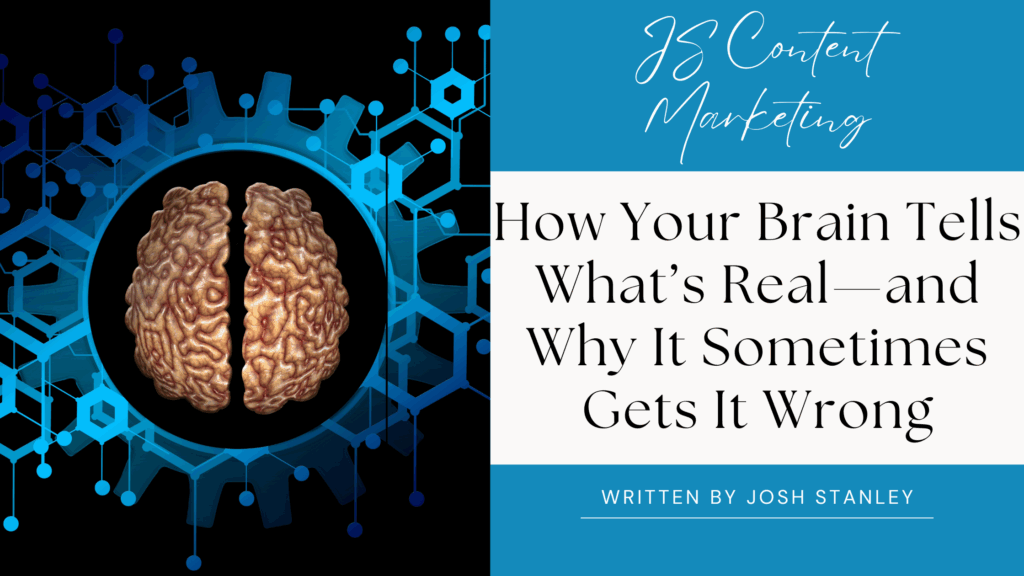How Your Brain Tells What’s Real—and Why It Sometimes Gets It Wrong

Recent neuroscience research from University College London reveals how our brains distinguish vivid imagination from actual perception.
A study published in Neuron used fMRI scans to track what happens in our minds when we both see and imagine visual patterns—and how the brain figures out which is real and which isn’t.
Even if you’re not a neuroscience major, this discovery could change your life. Specifically, it changes how we think about perception. It shows how important it is to question automatic thoughts and emotional reactions—because what seems real in the moment might be a very vivid mental creation.
In short, how we think shapes what we see, and learning to manage that process is a skill worth developing.
How Neuroscientists Put Imagination and Reality to the Test
In this experiment, 26 participants viewed gray squares—some containing faint diagonal lines—and simultaneously imagined similar lines. After each trial, they rated how vividly they saw the lines (on a 1–4 scale) and reported whether they believed the lines existed. This design allowed researchers to extract both perceptual and imagery neural signatures in real time.
The key player? The fusiform gyrus, a visual-processing region beneath the temples. Its activity rose not only when the lines were real, but also when participants imagined them vividly. Critically, when activation in this area was strong, participants often mistook imagined lines for real ones. This suggests the brain uses the intensity of fusiform signals as a rough proxy for reality—but when imagination becomes vivid, the lines between real and imagined experience can blur.
Enter the anterior insula, a region of the prefrontal cortex responsible for higher-order decision-making and self-awareness. The study found that once fusiform activity crossed a certain threshold, the anterior insula would “step in” to decide whether the experience was truly real. In essence, this area acts as a neural gatekeeper, comparing sensory intensity against an internal benchmark and delivering a binary verdict: imagination or perception?
This two-tier system—the fusiform gyrus gauging vividness, the anterior insula assessing reality—provides a new mechanistic explanation for how the brain keeps thoughts and perceptions separate. This insight aligns with computational models suggesting that distinguishing imagination from reality isn’t about different neural circuits, but about varying signal strength within shared circuits.
Why does this matter? When the system misfires—if fusiform signals are too strong during imagination, or if the insula fails to correctly interpret them—it can lead to hallucinations or distorted perceptions. Such breakdowns are often seen in psychiatric and neurological disorders like schizophrenia and Parkinson’s disease. Understanding these neural markers holds promise for better diagnostics and targeted treatments in the future.
What the Results Mean for Neuroscience and Everyday Life
Beyond clinical implications, these findings have a broader impact. As virtual reality becomes more immersive and digital experiences more vivid, knowing how the brain differentiates real from imagined could guide safer design. It also deepens our understanding of metacognition—how we reflect on and evaluate our own subjective experiences.
In summary, the study highlights:
- Shared neural circuits underlie both imagination and perception.
- The fusiform gyrus encodes vividness, which can influence our sense of reality.
- The anterior insula enforces reality judgment, preventing confusion.
- Disruption in either system may contribute to hallucinations and misperception.
- This adds clarity to the neuroscience of imagination, self-awareness, and mental health.
This research not only elevates our understanding of the mind’s reality-checking process but also opens new paths for clinical and technological innovation.
This research doesn’t just explain how hallucinations happen—it offers a powerful reminder about how flexible and subjective our reality can be. If your brain can sometimes confuse imagination with perception, what you believe or visualize may actually shape how you experience the world. That’s a big deal for mindset.
Practicing positive visualization, mindful awareness, and self-reflection can influence not just how we feel, but how we interpret what’s around us.

